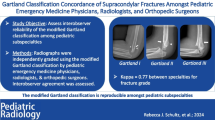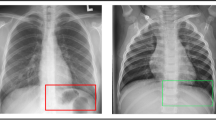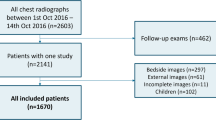Abstract
Background
In infant abuse investigations, dating of skeletal injuries from radiographs is desirable to reach a clear timeline of traumatic events. Prior studies have used infant birth-related clavicle fractures as a surrogate to develop a framework for dating of abuse-related fractures.
Objective
To develop and train a deep learning algorithm that can accurately date infant birth-related clavicle fractures.
Materials and methods
We modified a deep learning model initially designed for face-age estimation to date infant clavicle fractures. We conducted a computerized search of imaging reports and other medical records at a tertiary children’s hospital to identify radiographs of birth-related clavicle fracture in infants ≤ 3 months old (July 2003 to March 2021). We used the resultant database for model training, validation and testing. We evaluated the performance of the deep learning model via a four-fold cross-validation procedure, and calculated accuracy metrics: mean absolute error (MAE), root mean square error (RMSE), intraclass correlation coefficient (ICC) and cumulative score.
Results
The curated database consisted of 416 clavicle radiographs from 213 infants. Average chronological age (equivalent to fracture age) at time of imaging was 24 days. This model estimated the ages of the clavicle fractures with MAE of 4.2 days, RMSE of 6.3 days and ICC of 0.919. On average, 83.7% of the fracture age estimates were accurate to within 7 days of the ground truth.
Conclusion
Our deep learning study provides encouraging results for radiographic dating of infant clavicle fractures. With further development and validation, this model might serve as a virtual consultant to radiologists estimating fracture ages in cases of suspected infant abuse.






Similar content being viewed by others
References
Cumming WA (1979) Neonatal skeletal fractures. Birth trauma or child abuse? J Can Assoc Radiol 30:30–33
O’Connor JF, Cohen J (1987) Dating fractures. In: Kleinman PK (ed) Diagnostic imaging of child abuse. Williams & Wilkins, Baltimore, pp 103–113
Yeo LI, Reed MH (1994) Staging of healing of femoral fractures in children. Can Assoc Radiol J 45:16–19
Islam O, Soboleski D, Symons S et al (2000) Development and duration of radiographic signs of bone healing in children. AJR Am J Roentgenol 175:75–78
Malone CA, Sauer NJ, Fenton TW (2011) A radiographic assessment of pediatric fracture healing and time since injury. J Forensic Sci 56:1123–1130
Halliday K, Broderick N, Somers J, Hawkes R (2011) Dating fractures in infants. Clin Radiol 66:1049–1054
Prosser I, Lawon Z, Evans A et al (2012) A timetable for the radiologic features of fracture healing in young children. AJR Am J Roentgenol 198:1014–1120
Sanchez TR, Nguyen H, Palacios W et al (2013) Retrospective evaluation and dating of non-accidental rib fractures in infants. Clin Radiol 68:e467–e471
Warner C, Maguire S, Trefan L et al (2017) A study of radiological features of healing in long bone fractures among infants less than a year. Skeletal Radiol 46:333–341
Walters MM, Forbes PW, Buonomo C, Kleinman PK (2014) Healing patterns of clavicular birth injuries as a guide to fracture dating in cases of possible infant abuse. Pediatr Radiol 44:1224–1229
Fadell M, Miller A, Trefan L et al (2017) Radiological features of healing in newborn clavicular fractures. Eur Radiol 27:2180–2187
Yang P, Zhong L, Metaxas D (2010) Ranking model for facial age estimation. 2010 20th International Conference on Pattern Recognition. IEEE, pp 3404–3407
Chang KY, Chen CS, Hung YP (2011) Ordinal hyperplanes ranker with cost sensitivities for age estimation. 2011 IEEE Conference on Computer Vision and Pattern Recognition (CVPR). IEEE, pp 585–592
Li C, Liu Q, Liu J, Lu H (2012) Learning ordinal discriminative features for age estimation. CVPR, IEEE, pp 2570–2577
Niu Z, Zhou M, Wang L et al (2016) Ordinal regression with multiple output CNN for age estimation. 2016 IEEE Conference on Computer Vision and Pattern Recognition (CVPR). IEEE, pp 4920–4928
Cao W, Mirjalili V, Raschka S (2020) Rank consistent regression for neural networks with application to age estimation. Pattern Recognit Lett 140:325–331
PyTorch (2022) Tensors and dynamic neural networks in Python with strong GPU acceleration. https://github.com/pytorch/pytorch. Accessed 8 Apr 2022
Refaeilzadeh P, Tang L, Liu H (2009) Cross-validation. In: Liu L, Özsu MT (eds) Encyclopedia of database systems. Springer, Boston
Koch GG (1982) Intraclass correlation coefficient. In: Kotz S, Johnson NL (eds) Encyclopedia of statistical sciences, vol 4. Wiley, New York, pp 213–217
Cicchetti DV (1994) Guidelines, criteria, and rules of thumb for evaluating normed and standardized assessment instruments in psychology. Psychol Assess 6:284–290
Eng DK, Khandwala NB, Long J et al (2021) Artificial intelligence algorithm improves radiologist performance in skeletal age assessment: a prospective multicenter randomized controlled trial. Radiology 301:692–699
Pan SJ, Yang Q (2018) A survey on transfer learning. IEEE Trans Knowl Data Eng 22:1345–1359
Kermany DS, Goldbaum M, Cai W et al (2018) Identifying medical diagnoses and treatable diseases by image-based deep learning. Cell 172:1122–1131
Coudray N, Ocampo PS, Sakellaropoulos T et al (2018) Classification and mutation prediction from non–small cell lung cancer histopathology images using deep learning. Nat Med 24:1559–1567
Kather JN, Pearson AT, Halama N et al (2019) Deep learning can predict microsatellite instability directly from histology in gastrointestinal cancer. Nat Med 25:1054–1056
Tompson J, Goroshin R, Jain A et al (2015) Efficient object localization using convolutional networks. 2015 IEEE Conference on Computer Vision and Pattern Recognition (CVPR). IEEE, pp 648–656
Lei W, Xu W, Gu R et al (2021) Contrastive learning of relative position regression for one-shot object localization in 3D medical images. 24th International Conference on Medical Image Computing & Computer Assisted Intervention (MICCAI2021), pp 155–165
Rozenberg E, Freedman D, Bronstein AA (2021) Learning to localize objects using limited annotation, with applications to thoracic diseases. IEEE Access 9:67620–67633
Kumar D, Wong A, Taylor GW (2017) Explaining the unexplained: a class-enhanced attentive response (CLEAR) approach to understanding deep neural networks. 2017 IEEE Conference on Computer Vision and Pattern Recognition Workshops (CVPRW). IEEE, pp 36–44
Kindermans P, Schutt KT, Alber M et al (2018) Learning how to explain neural networks: PatternNet and PatternAttribution. 6th International Conference on Learning Representation, Vancouver
Zintgraf LM, Cohen TS, Adel T, Welling M (2017) Visualizing deep neural network decisions: prediction difference analysis. 5th International Conference on Learning Representation
Acknowledgments
This project was supported by the Radiological Society of North America (RSNA) Research & Education Foundation, through Research Seed Grant RSD2133 to Andy Tsai.
Author information
Authors and Affiliations
Corresponding author
Ethics declarations
Conflicts of interest
None
Additional information
Publisher’s note
Springer Nature remains neutral with regard to jurisdictional claims in published maps and institutional affiliations.
Rights and permissions
About this article
Cite this article
Tsai, A., Grant, P.E., Warfield, S.K. et al. Deep learning of birth-related infant clavicle fractures: a potential virtual consultant for fracture dating. Pediatr Radiol 52, 2206–2214 (2022). https://doi.org/10.1007/s00247-022-05380-0
Received:
Revised:
Accepted:
Published:
Issue Date:
DOI: https://doi.org/10.1007/s00247-022-05380-0




